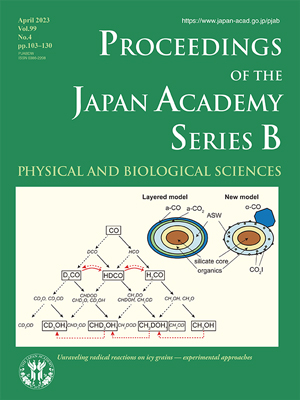About the Cover
Vol. 99 No. 4 (2023)
Astronomical observations have identified more than 150 kinds of chemical species in interstellar molecular clouds. Because planetary systems are born in molecular clouds, chemical reactions occurring there are considered to be crucial for determining the composition of primordial matter for planetary system formation. It has been recognized that chemical reactions on icy dust grains are indispensable for producing a large variety and abundance of chemical species; the experimentally revealed complex structure of icy grains is shown in the cover figure. Under low-temperature conditions, the radical reactions that can proceed even at temperatures as low as 10 K play key roles. However, in spite of their importance, the details of radical behaviors on ice have not been clarified because of experimental difficulties for the in situ detection of radicals.
Since the 2000s, a research group led by Naoki Watanabe (the author of the paper in this issue, pp. 103–130) has played a central role in revealing the elemental physicochemical processes on icy dust grains. They have developed several experimental methods to demonstrate the formation processes of astronomically abundant molecules such as H2, H2O, H2CO (formaldehyde), and CH3OH (methanol). Moreover, as shown in the cover figure, they clarified, for the first time, that the deuteration of formaldehyde and methanol significantly proceeds by H–D tunneling substitution reactions on ice. Their findings can explain the extreme deuterium enrichments in CH3OH, and puzzling difference between CH2DOH and CH3OD in astronomical observations of molecular clouds.
In recent years, they developed highly sensitive and non-destructive methods to detect free radicals on ice, which have contributed to understanding the formation of complex organic molecules (COMs). The formation mechanisms of COMs have attracted much attention because of significant advances in observational studies, in particular, using the Atacama Large Millimeter/submillimeter Array (ALMA) and James Webb Space Telescope (JWST). In the era of high sensitivity and spatial resolution in astronomical observations, the experimental methods developed by these authors are promising for further revealing the elemental physicochemical processes on icy dust grains and contribute to our understanding of chemical evolution in molecular clouds.
Yuri Aikawa
Professor, Department of Astronomy, Graduate School of Science, The University of Tokyo




